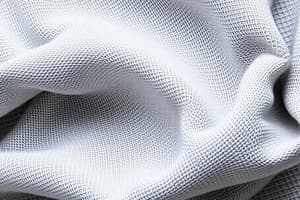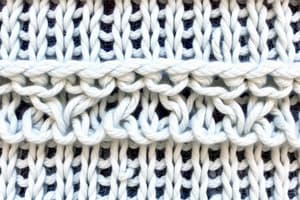Podcast
Questions and Answers
What is the primary purpose of pre-production sampling and testing in garment making?
What is the primary purpose of pre-production sampling and testing in garment making?
- To sell garments at a retail store
- To maintain quality standards for knitted garments (correct)
- To advertise new products
- To finalize the garment design
Record keeping of quality-control procedures is unnecessary for process improvement.
Record keeping of quality-control procedures is unnecessary for process improvement.
False (B)
What must be done with garment defects to ensure standards are maintained?
What must be done with garment defects to ensure standards are maintained?
Garment defects must be identified and rectified.
A well-constructed control system helps identify and correct any __________ in the production process.
A well-constructed control system helps identify and correct any __________ in the production process.
Match the following quality control aspects with their descriptions:
Match the following quality control aspects with their descriptions:
What is a primary consideration when cutting knitted fabrics?
What is a primary consideration when cutting knitted fabrics?
Over-stitching is used on the raw edges of knit fabrics to enhance fraying.
Over-stitching is used on the raw edges of knit fabrics to enhance fraying.
Name one type of cutting tool used for knitted fabrics.
Name one type of cutting tool used for knitted fabrics.
The type of __________ used for stitching knits is often different from those used for woven fabrics.
The type of __________ used for stitching knits is often different from those used for woven fabrics.
Match the following procedures with their purposes in knitted garment production:
Match the following procedures with their purposes in knitted garment production:
Which of the following is a key factor in stitching knit fabrics?
Which of the following is a key factor in stitching knit fabrics?
Automated cutting tools are typically used for low-volume production of knitted garments.
Automated cutting tools are typically used for low-volume production of knitted garments.
What method helps in optimizing yarn utilization when working with knitted fabrics?
What method helps in optimizing yarn utilization when working with knitted fabrics?
Flashcards
Cutting Knit Fabrics
Cutting Knit Fabrics
Knit fabrics have unique properties like stretch and drape, requiring specialized cutting techniques to minimize waste and utilize yarn efficiently.
Stitching Knit Fabrics
Stitching Knit Fabrics
Knitted fabrics have a different structure and elasticity requiring specialized stitching techniques that accommodate stretch and prevent distortion.
Pattern Layout in Knit Fabric Cutting
Pattern Layout in Knit Fabric Cutting
Pattern layouts in knit fabric cutting are crucial for minimizing yarn waste and optimizing the use of the material.
Pattern Marking for Knit Garments
Pattern Marking for Knit Garments
Signup and view all the flashcards
Specialized Tools for Knit Fabric Cutting
Specialized Tools for Knit Fabric Cutting
Signup and view all the flashcards
Stitching Techniques for Knit Fabrics
Stitching Techniques for Knit Fabrics
Signup and view all the flashcards
Specialized Machines for Stitching Knit Fabrics
Specialized Machines for Stitching Knit Fabrics
Signup and view all the flashcards
Quality Control in Knit Garment Production
Quality Control in Knit Garment Production
Signup and view all the flashcards
Quality control in garment production
Quality control in garment production
Signup and view all the flashcards
Pre-production sampling
Pre-production sampling
Signup and view all the flashcards
Post-production quality testing
Post-production quality testing
Signup and view all the flashcards
Record keeping in quality control
Record keeping in quality control
Signup and view all the flashcards
Feedback in quality control
Feedback in quality control
Signup and view all the flashcards
Study Notes
Knitted Garment Cutting
- Knitted fabrics are cut using specialized patterns and techniques, differing from woven fabrics due to the inherent stretch and drape of knits.
- Pattern layouts are crucial for minimizing fabric waste and optimizing yarn use. Methods vary based on the type of knitting stitch, the machine, and the end product.
- Considerations include the stretch and recovery properties of the specific yarn and knit.
- Accurate pattern marking ensures consistent fabric positioning during cutting.
- Fabric cutting tools include rotary cutters, specialized blades/shears for preventing damage to knits. Automated cutting tools are used for high-volume production.
Knitted Garment Stitching
- Stitching methods differ for knit fabrics versus woven fabrics, accommodating the elongation/recovery of knits to prevent distortion.
- Stitching techniques are vital for stitch strength and to prevent fabric ripping/snagging, while accounting for knit stretch.
- Specialized needles and thread types are necessary for knits, differing from those used in woven garments.
- Seams should be strategically placed to create smooth, even fabric joints.
- Seam allowances and stitch lengths must be adjusted for knits based on their properties compared to woven fabrics.
- Over-stitching is often applied to the raw edges of knit fabrics to prevent fraying and maintain garment shape.
- Specialized industrial sewing machines are often used for stitching knits, suitable for fabric feed, stitch type, and tension control.
Knitted Garment Quality Control
- Quality control checks are crucial throughout knit garment production, both pre- and post-production.
- Initial fabric inspection assesses yarn quality and material appearance (color, flaws).
- Dimensional accuracy and uniformity (length, width, circumference) are checked against prescribed standards for each garment.
- Stitching is inspected for evenness, strength, absence of puckers, and seam quality.
- Garment fit, drape, and appearance are evaluated, potentially involving modeling for fit confirmation.
- Checks during stitching can identify potential issues in production, while post-production checks evaluate sewing and handling flaws.
- Pre-production sampling and testing, and post-production tests are essential for maintaining quality standards, focusing on stretch/recovery properties.
- Garments must satisfy predetermined specifications and quality ratings.
- Identifying and rectifying garment defects is crucial for maintaining standards and customer satisfaction.
- Detailed record keeping of quality control procedures and results is key for process improvements.
- A comprehensive quality control system helps identify and fix flaws, problems, and irregularities in knit garment production. Feedback is vital for improving quality, production time, efficiency, and costs.
Studying That Suits You
Use AI to generate personalized quizzes and flashcards to suit your learning preferences.




